Home / Thionyl Chloride (SOCl2) And Conversion of Carboxylic Acids to Acid Halides
Carboxylic Acid Derivatives
Thionyl Chloride (SOCl2) And Conversion of Carboxylic Acids to Acid Halides
Last updated: April 18th, 2025 |
Thionyl Chloride, SOCl2 – Reaction With Carboxylic Acids to Give Acid Halides
- Thionyl chloride (SOCl2) is a useful reagent for converting carboxylic acids to acid chlorides.
- Can also be used to convert alcohols to alkyl halides, covered in this post (See article: SOCl2 and PBr3 – also good to be aware of the SNi mechanism – SOCl2 and the SNi Mechanism)
- Acid halides can be converted into a great number of other functional groups (esters, amides, anhydrides, and also aldehydes and ketones) through nucleophilic acyl substitution, so this reagent is extremely useful in synthesis.
- Other reagents that perform the same transformation are PCl3, PCl5, oxalyl chloride, and the related bromine reagents.
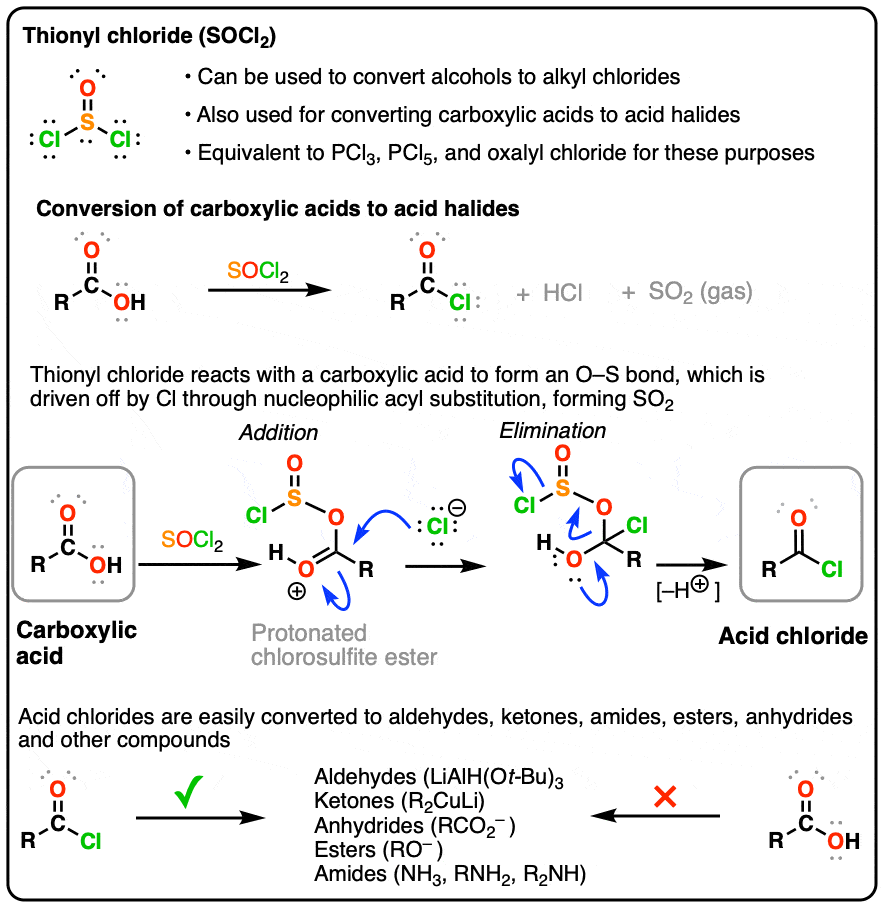
Table of Contents
1. Lewis Structure of Thionyl Chloride (SOCl2)
Thionyl chloride (SOCl2) is a useful reagent for converting alcohols to alkyl halides and for converting carboxylic acids to acid chlorides. We’ve met it previously in the chapter on alcohols. (See article – SOCl2 and PBr3)
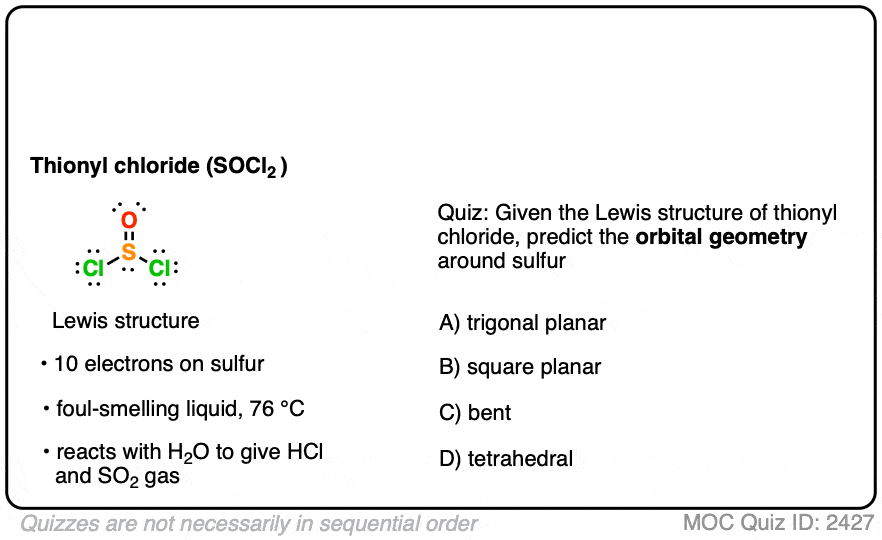 Click to Flip
Click to Flip
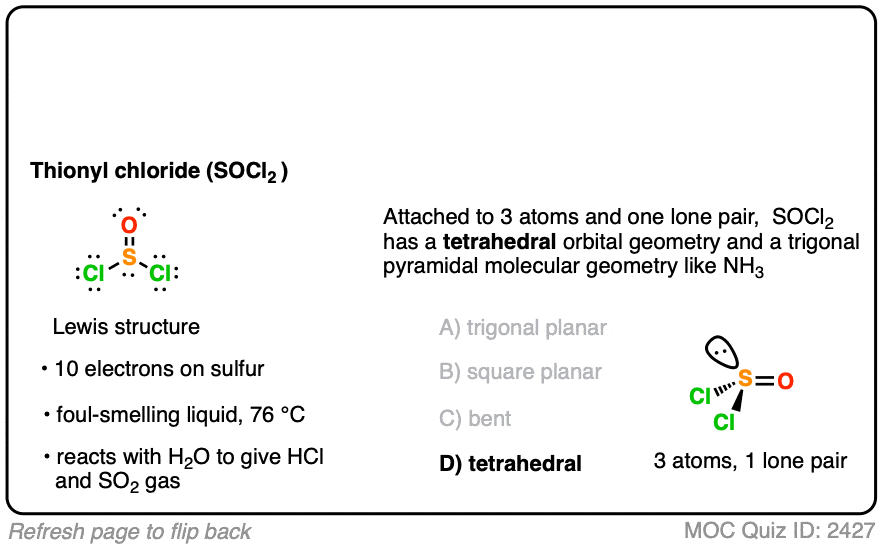
SOCl2 has a sickly-sweet odor to it, like rotten eggs that have been doused in sweetener: once experienced, never forgotten. If you’ve ever had the (non-)pleasure of walking next to a pulp and paper mill, it’s very similar to the smell of sulfur dioxide.
The geometry of thionyl chloride is interesting. There are actually ten (10) valence electrons on thionyl chloride, and it adopts a geometry where one of the lone pairs occupies an orbital. With three attached atoms and one lone pair, this results in a tetrahedral arrangement of orbitals and a trigonal pyramidal molecular geometry (similar to NH3).
In this article we’ll mainly be discussing thionyl chloride’s use in converting carboxylic acids to acid chlorides, a property it shares with several other reagents such as phosphorus trichloride (PCl3), phosphorus pentachloride (PCl5), and oxalyl chloride.
We’ll also show some applications of thionyl chloride in synthesis problems.
(Thionyl chloride (SOCl2) is sometimes confused with sulfuryl chloride (SO2Cl2); sulfuryl chloride performs many of the same reactions as elemental chlorine (Cl2) while being more convenient to handle.)
2. Conversion Of Carboxylic Acids To Acid Chlorides
Thionyl chloride converts carboxylic acids into acid chlorides (“acyl chlorides”). Here is a general example, along with some specific examples.
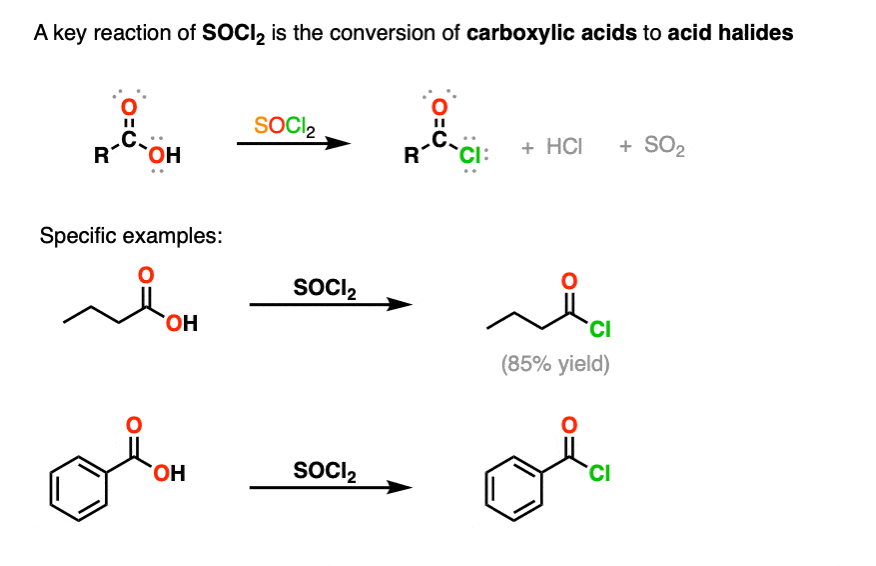
The reaction also works with the related reagents PCl3, PCl5, and oxalyl chloride, which are considered to be equivalent for our purposes.
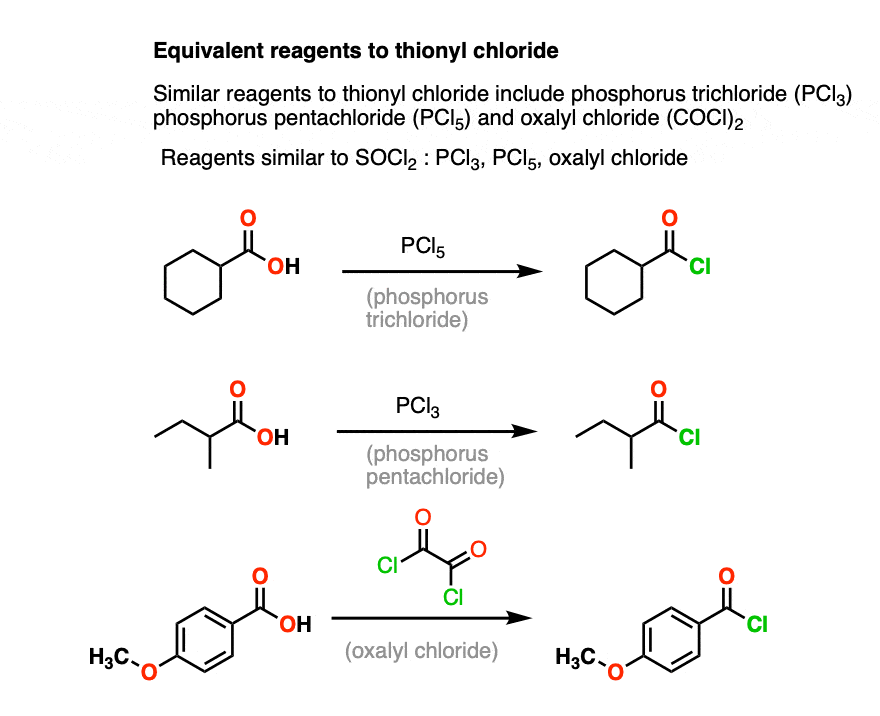
This is a useful reaction since it converts the poor leaving group HO(-) into the good leaving group Cl(-), which makes the carbonyl group much more likely to undergo nucleophilic acyl substitution reactions. (See post: Nucleophilic Acyl Substitution Under Basic Conditions)
For specific applications, see section 4 below.
So how does it work?
3. Carboxylic Acids To Acid Chlorides With SOCl2 – The Mechanism
Thionyl chloride reacts with carboxylic acids to give an acid halide, sulfur dioxide (SO2) and HCl.
The initial reaction is between the carboxylic acid (as a nucleophile) attacking the (electrophilic) sulfur atom, resulting in replacement of H with SO2Cl. [Note 1 – this is called a “chlorosulfite ester”]
A key point of the first step is to show the carbonyl oxygen acting as the nucleophile! (Why not the OH? See Quiz 1 )
The loss of chlorine from sulfur can be shown in two different ways.
- One way to show this reaction happening is through an addition-elimination reaction at sulfur, except that the S-O (pi) bond breaks (addition) and then re-forms (elimination), driving off Cl(-) as the leaving group. [Note 2 – not much double bond character in S-O (pi).]
To see this mechanism, hover here or click this link.
- Another way to show it (below) is a direct displacement at sulfur, which is tetrahedral, after all. In this sense we can think of this reaction as being a lot like an SN2 reaction at sulfur.
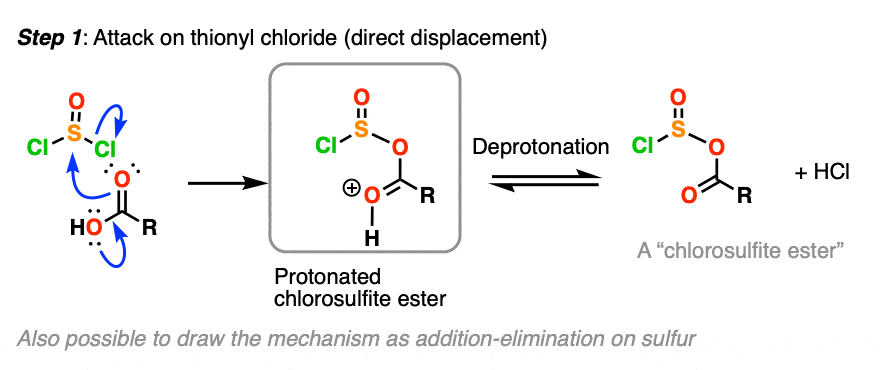
Once the chlorosulfite ester is formed, the acid chloride is formed through a classic addition-elimination mechanism.
- the chloride ion then attacks the carbonyl carbon, leading to formation of C-Cl, breakage of C-O (pi).
- The C-O pi bond is re-formed, and the C-O bond is broken.
The resulting (protonated) acid chloride is then deprotonated by Cl(-) to give the acid chloride.
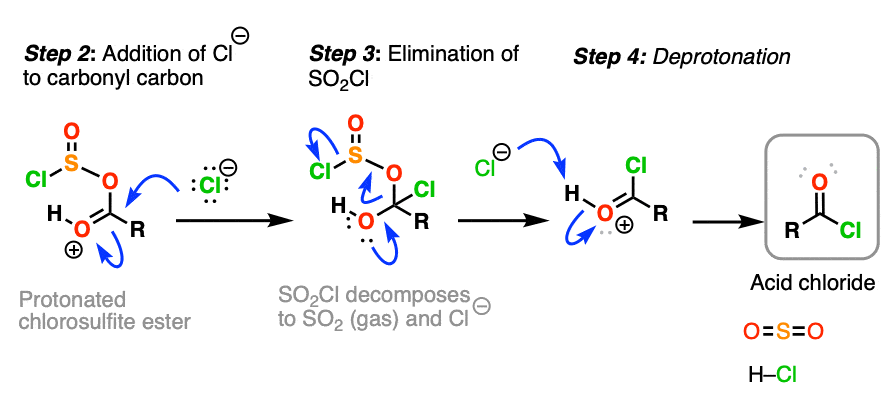
Meanwhile, the (-)O-SOCl decomposes to give foul-smelling sulfur dioxide (SO2) which bubbles off as a gas, rendering the reaction irreversible. (Reactions involving thionyl chloride should always be performed in well-ventilated fume hood – Note 3).
4. Acid Halides In Synthesis
All right. So carboxylic acids can be converted into acid halides. Now what?
Well, it opens up a whole new set of possibilities. Acyl halides undergo nucleophilic acyl substitution much more readily than carboxylic acids.
If carboxylic acids are treated with amines, alkoxides, or carboxylates (among others) the only product that will form is a deprotonated carboxylic acid (carboxylate).
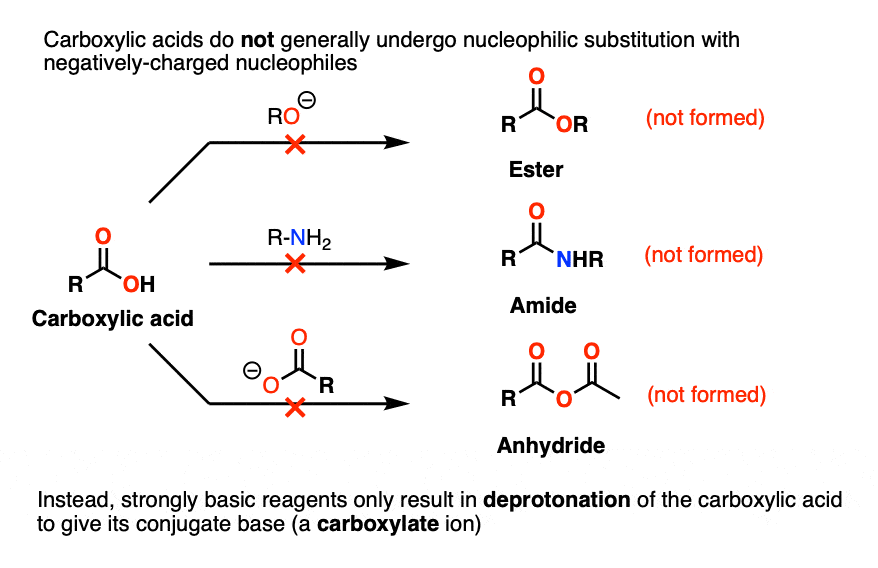
As discussed earlier, that’s because under basic conditions, the leaving group of a carboxylic acid is not the hydroxide ion (HO-) but the di-anionic (and extremely basic) O(2-).
Carboxylic acids undergo nucleophilic acyl substitution under acidic conditions, but that’s a different story. (See Carbonyl Mechanisms – Elimination)
Once the carboxylic acid is converted into an acid halide, however, a large number of nucleophilic acyl substitution reactions become possible.
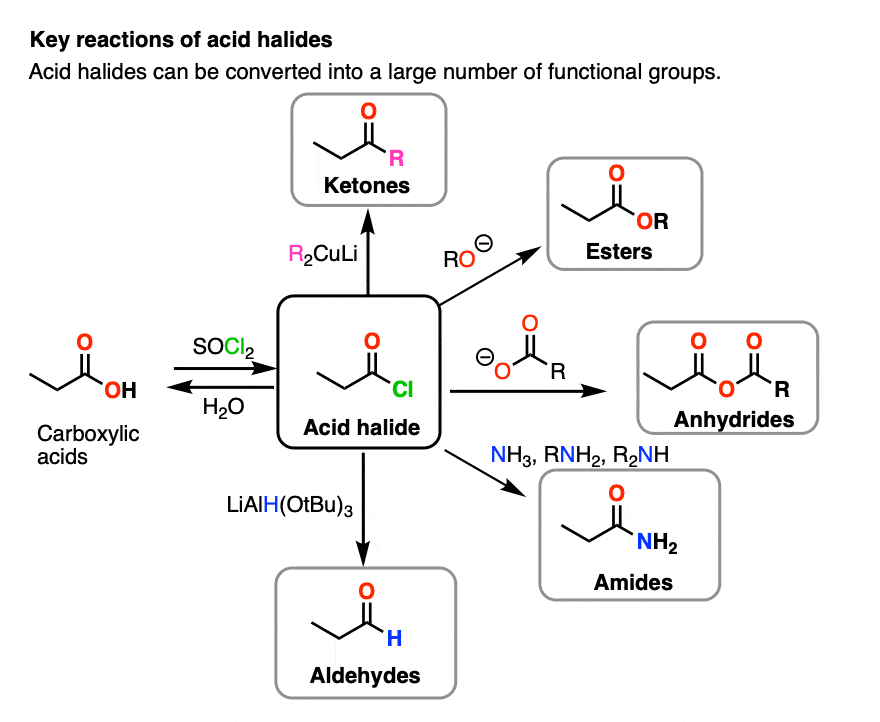
5. Applications – Synthesis Problems
Once this reaction is in your synthetic toolbox, it opens up solutions to a wide range of solutions to synthesis problems.
See if you can come up with two-step pathways to synthesize each of the three molecules below.
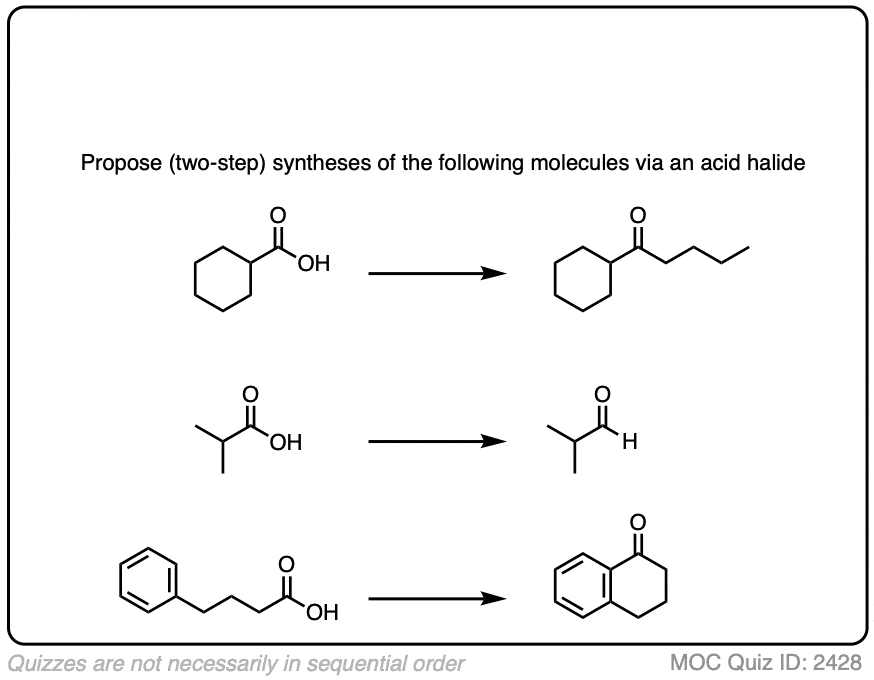 Click to Flip
Click to Flip
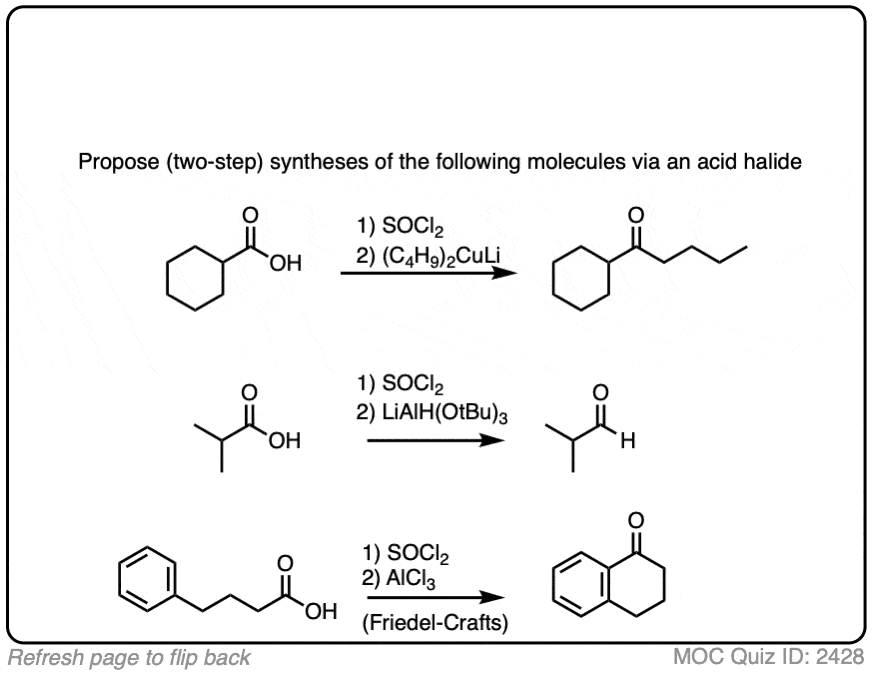
The way in which SOCl2 enables conversion of carboxylic acids to much more versatile acid halides is extremely similar to how SOCl2 allows conversion of alcohols to alkyl halides, which can subsequently be converted into a huge range of different products via SN1/SN2/E1/E2 reactions (See, for example, The Power of the SN2 Reaction)
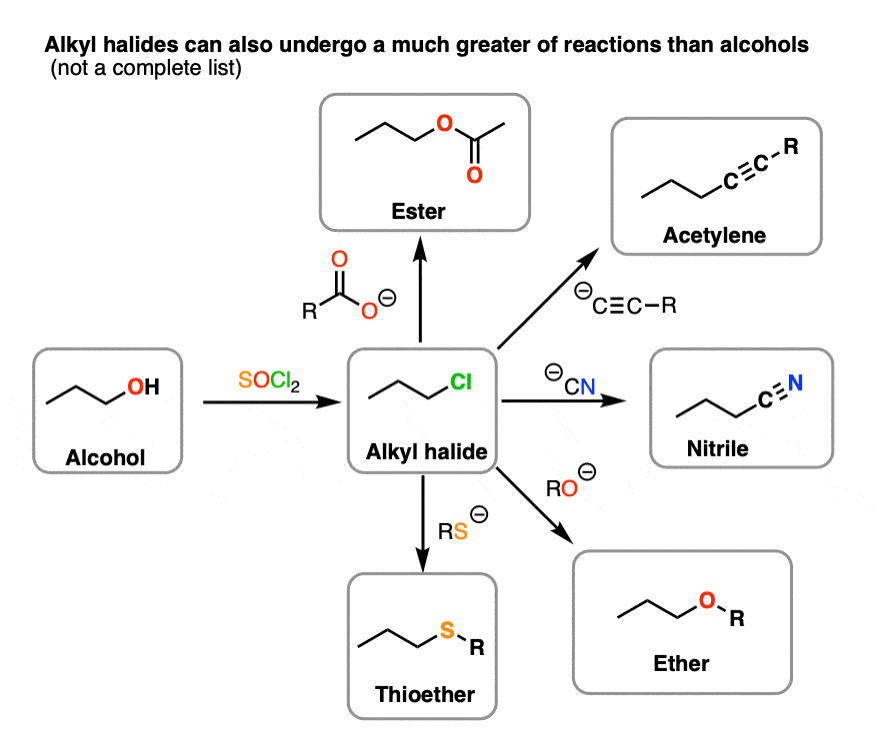
6. Summary
- Thionyl chloride can convert carboxylic acids to acid halides.
- The acid halides can then be converted into aldehydes, ketones, anhydrides, esters, amides or a number of other functional groups. (Including back to a carboxylic acid – just add water! )
- In this way, carboxylic acids can be converted (in about 2 steps) into a large variety of different carbonyl compounds.
- You must know this reaction (or others like it, i.e. PCl3, PCl5, oxalyl chloride) if you are going to successfully plan out syntheses of carboxylic acid derivatives.
Notes
Related Articles
Note 1. This has the effect of replacing the OH with the good leaving group (-)OSOCl, which is the conjugate base of the (unstable) molecule chlorosulfinic acid. As soon as (-)OSOCl is displaced, it almost immediately breaks down to sulfur dioxide (SO2) gas and chloride ion.
Note 2. It’s very tempting to think of the S=O bond as behaving a lot like the C=O bond and undergoing similar reaction pathways like addition-elimination.
The correlation between C=O and S=O isn’t that great however. As noted previously, the sulfur atom is tetrahedral, not trigonal planar; the energetic “penalty” for losing a leaving group on an sp2 hybridized atom is considerably less for the heavier, more polarizable sulfur than it is for carbon. Furthermore it the S-O “pi bond” does not have very much double bond character. It is often written as S(+)-O(-) to reflect the highly polar nature of this bond.
So although you may see this mechanism written, it is an open question as to how well it corresponds to reality.
Note 3. One accident that occurred during my time as a TA involved a student dropping a flask with 5 mL of thionyl chloride into a rotovap bath outside the fume hood. The cloud of SO2 and HCl that formed cleared the teaching lab for half an hour, so you can imagine what thionyl chloride would do if exposed to the moisture in your lungs. Treat with caution, just as you would if you were working with phosgene.
Quiz Yourself!
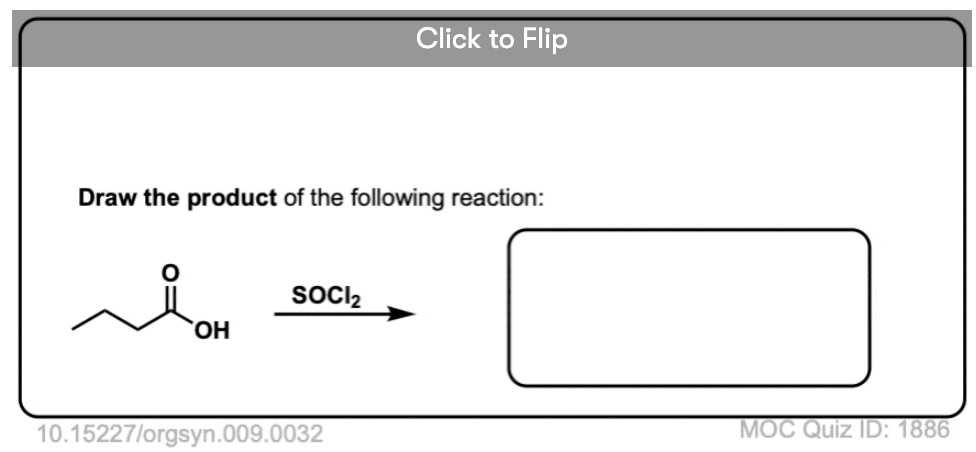
Become a MOC member to see the clickable quiz with answers on the back.
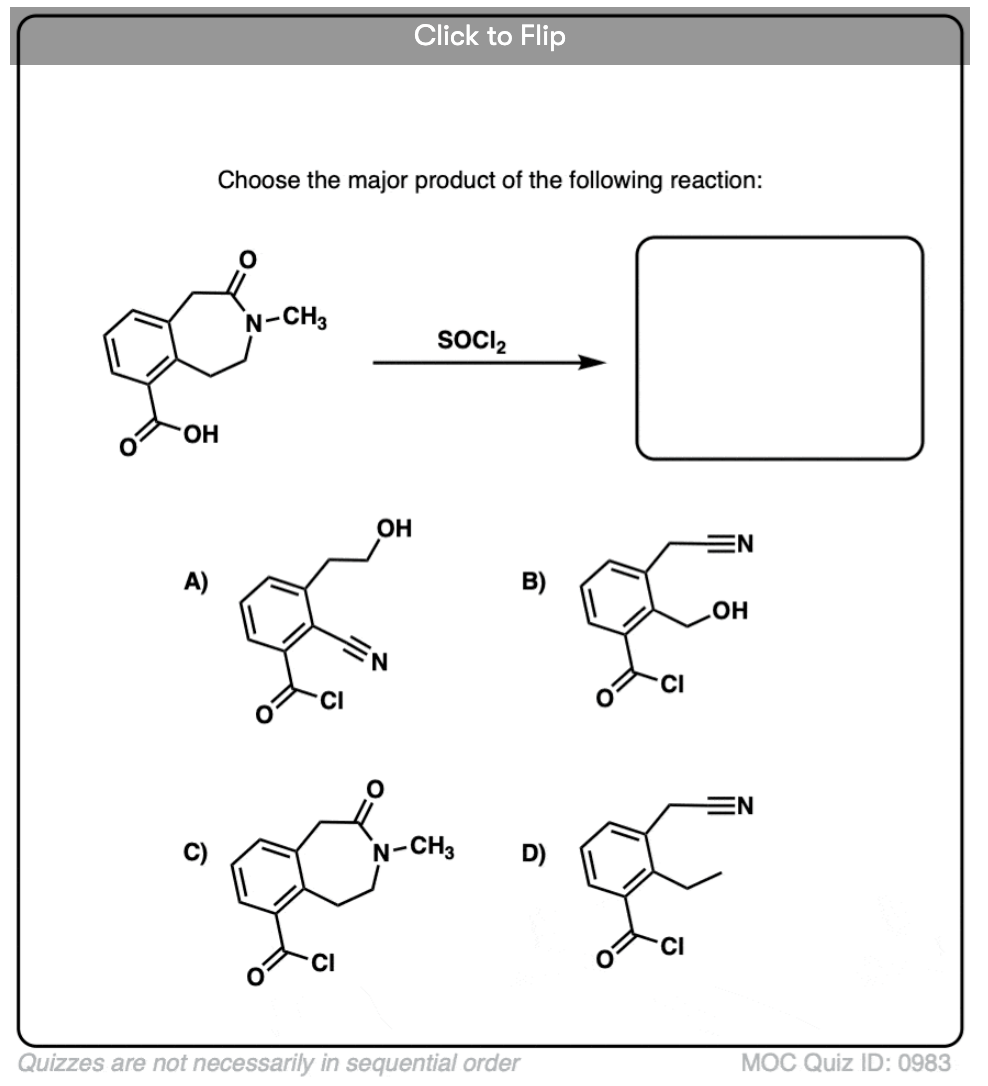
Become a MOC member to see the clickable quiz with answers on the back.
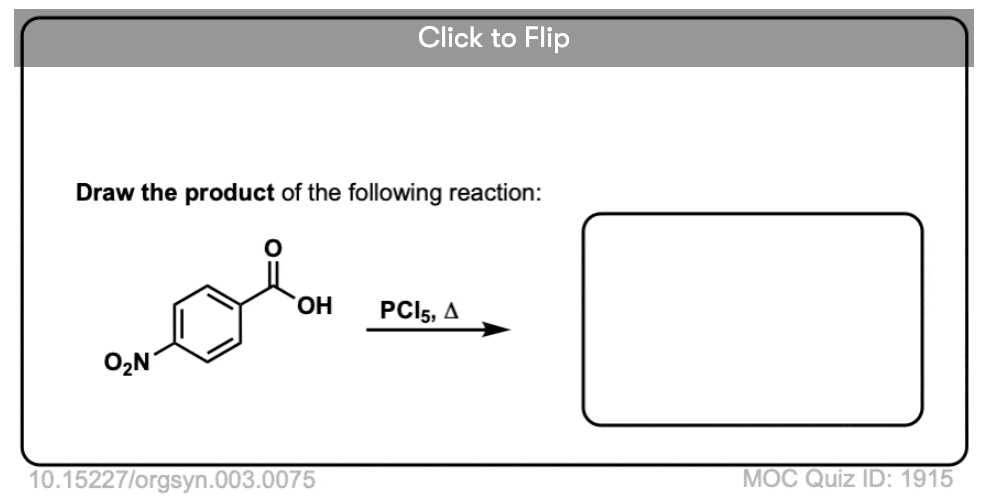
Become a MOC member to see the clickable quiz with answers on the back.
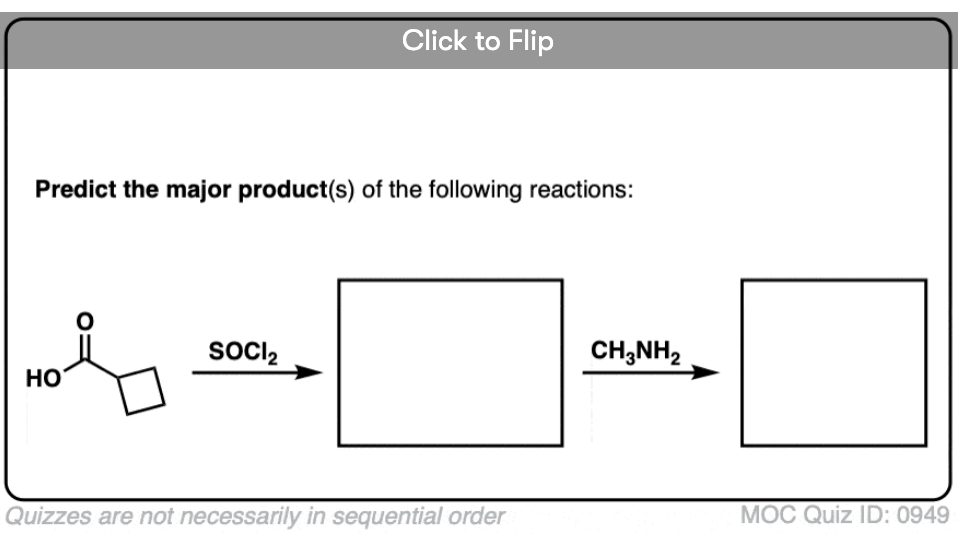
Become a MOC member to see the clickable quiz with answers on the back.
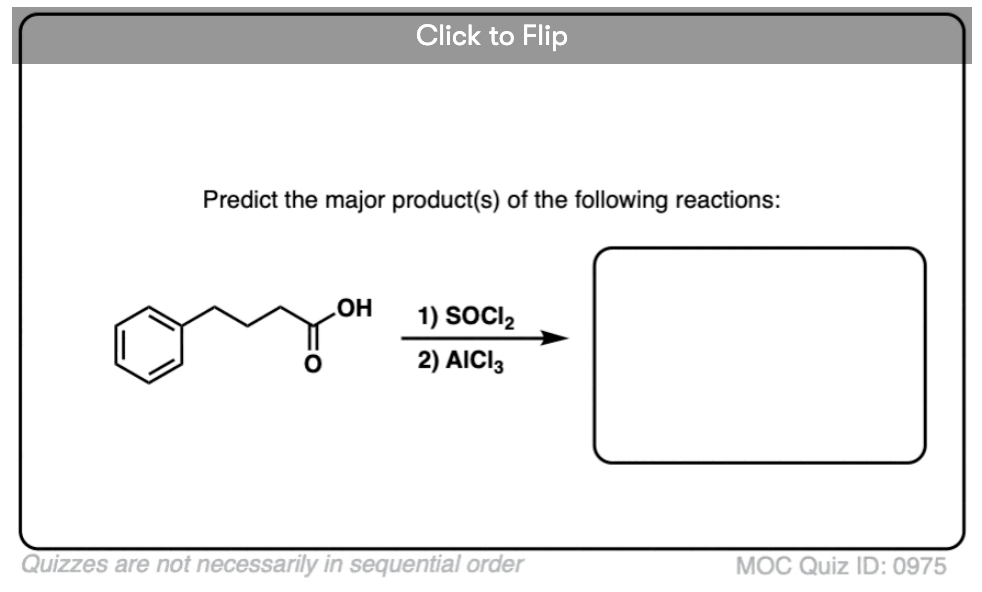
Become a MOC member to see the clickable quiz with answers on the back.
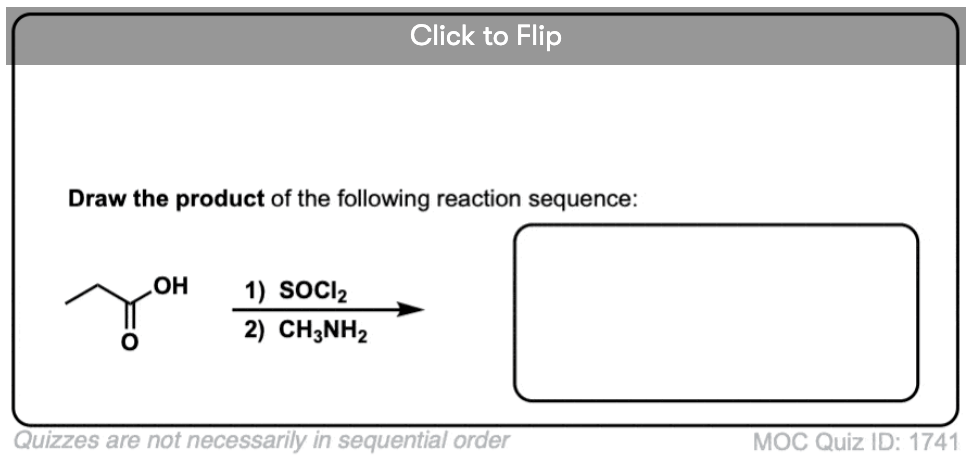
Become a MOC member to see the clickable quiz with answers on the back.
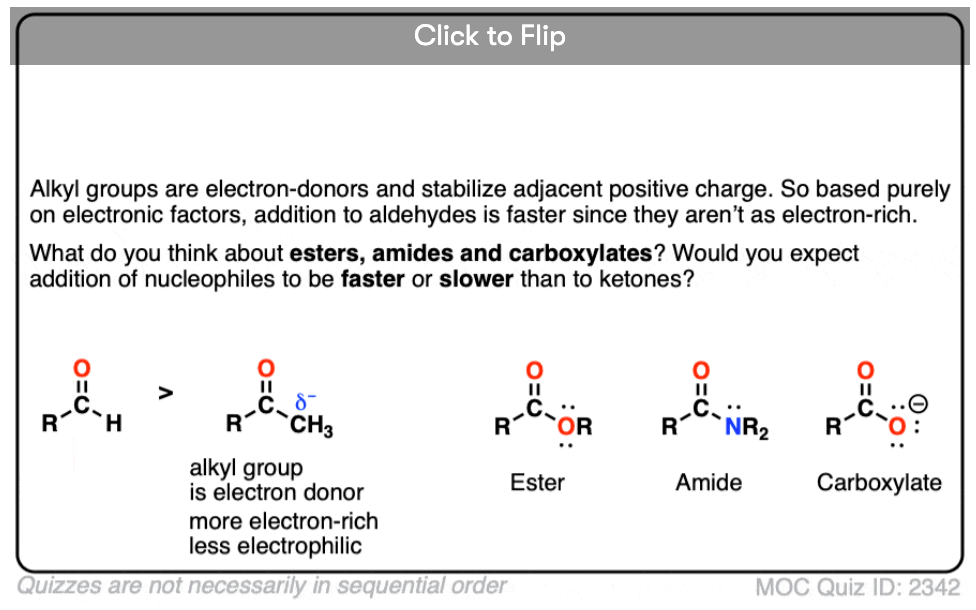
Become a MOC member to see the clickable quiz with answers on the back.
(Advanced) References and Further Reading
- Phthalyl Chloride
P. Kyrides
Journal of the American Chemical Society 1937, 59 (1), 206-208
DOI: 10.1021/ja01280a051
An early paper on the conversion of phthalic anhydride to the diacid with SOCl2, as well as the reverse reaction, which can regenerate SOCl2. - Structure of Succinyl Dichloride and of Certain Other Potentially Cyclic Difunctional Compounds
JAMES CASON and ELMER J. REIST
The Journal of Organic Chemistry 1958, 23 (10), 1492-1496
DOI:10.1021/jo01104a024
In this paper, succinyl dichloride is only obtained from the acid with an excess of SOCl2 and a catalytic amount of pyridine. Pyridine can be used to catalyze the reaction of SOCl2 with carboxylic acids. - Eine Methode zur katalysierten Herstellung von Carbonsäure‐ und Sulfosäure‐chloriden mit Thionylchlorid
H. Bosshard R. Mory M. Schmid Hch. Zollinger
Helv. Chim. Acta 1959, 42 (5), 1653-1658
DOI: 10.1002/hlca.19590420526
This paper discusses how DMF (N,N-dimethylformamide, a common solvent) can be used to catalyze the reaction of SOCl2 with carboxylic acids, which is commonly used today. - n-BUTYRYL CHLORIDE
Helferich and W. Schaefer
Org. Synth. 1929, 9, 32
DOI: 10.15227/orgsyn.009.0032
A classic procedure for the conversion of carboxylic acids to acid chloride with SOCl2 from Organic Syntheses, a reliable source of independently tested organic transformations.
00 General Chemistry Review
01 Bonding, Structure, and Resonance
- How Do We Know Methane (CH4) Is Tetrahedral?
- Hybrid Orbitals and Hybridization
- How To Determine Hybridization: A Shortcut
- Orbital Hybridization And Bond Strengths
- Sigma bonds come in six varieties: Pi bonds come in one
- A Key Skill: How to Calculate Formal Charge
- The Four Intermolecular Forces and How They Affect Boiling Points
- 3 Trends That Affect Boiling Points
- How To Use Electronegativity To Determine Electron Density (and why NOT to trust formal charge)
- Introduction to Resonance
- How To Use Curved Arrows To Interchange Resonance Forms
- Evaluating Resonance Forms (1) - The Rule of Least Charges
- How To Find The Best Resonance Structure By Applying Electronegativity
- Evaluating Resonance Structures With Negative Charges
- Evaluating Resonance Structures With Positive Charge
- Exploring Resonance: Pi-Donation
- Exploring Resonance: Pi-acceptors
- In Summary: Evaluating Resonance Structures
- Drawing Resonance Structures: 3 Common Mistakes To Avoid
- How to apply electronegativity and resonance to understand reactivity
- Bond Hybridization Practice
- Structure and Bonding Practice Quizzes
- Resonance Structures Practice
02 Acid Base Reactions
- Introduction to Acid-Base Reactions
- Acid Base Reactions In Organic Chemistry
- The Stronger The Acid, The Weaker The Conjugate Base
- Walkthrough of Acid-Base Reactions (3) - Acidity Trends
- Five Key Factors That Influence Acidity
- Acid-Base Reactions: Introducing Ka and pKa
- How to Use a pKa Table
- The pKa Table Is Your Friend
- A Handy Rule of Thumb for Acid-Base Reactions
- Acid Base Reactions Are Fast
- pKa Values Span 60 Orders Of Magnitude
- How Protonation and Deprotonation Affect Reactivity
- Acid Base Practice Problems
03 Alkanes and Nomenclature
- Meet the (Most Important) Functional Groups
- Condensed Formulas: Deciphering What the Brackets Mean
- Hidden Hydrogens, Hidden Lone Pairs, Hidden Counterions
- Don't Be Futyl, Learn The Butyls
- Primary, Secondary, Tertiary, Quaternary In Organic Chemistry
- Branching, and Its Affect On Melting and Boiling Points
- The Many, Many Ways of Drawing Butane
- Wedge And Dash Convention For Tetrahedral Carbon
- Common Mistakes in Organic Chemistry: Pentavalent Carbon
- Table of Functional Group Priorities for Nomenclature
- Summary Sheet - Alkane Nomenclature
- Organic Chemistry IUPAC Nomenclature Demystified With A Simple Puzzle Piece Approach
- Boiling Point Quizzes
- Organic Chemistry Nomenclature Quizzes
04 Conformations and Cycloalkanes
- Staggered vs Eclipsed Conformations of Ethane
- Conformational Isomers of Propane
- Newman Projection of Butane (and Gauche Conformation)
- Introduction to Cycloalkanes
- Geometric Isomers In Small Rings: Cis And Trans Cycloalkanes
- Calculation of Ring Strain In Cycloalkanes
- Cycloalkanes - Ring Strain In Cyclopropane And Cyclobutane
- Cyclohexane Conformations
- Cyclohexane Chair Conformation: An Aerial Tour
- How To Draw The Cyclohexane Chair Conformation
- The Cyclohexane Chair Flip
- The Cyclohexane Chair Flip - Energy Diagram
- Substituted Cyclohexanes - Axial vs Equatorial
- Ranking The Bulkiness Of Substituents On Cyclohexanes: "A-Values"
- Cyclohexane Chair Conformation Stability: Which One Is Lower Energy?
- Fused Rings - Cis-Decalin and Trans-Decalin
- Naming Bicyclic Compounds - Fused, Bridged, and Spiro
- Bredt's Rule (And Summary of Cycloalkanes)
- Newman Projection Practice
- Cycloalkanes Practice Problems
05 A Primer On Organic Reactions
- The Most Important Question To Ask When Learning a New Reaction
- Curved Arrows (for reactions)
- Nucleophiles and Electrophiles
- The Three Classes of Nucleophiles
- Nucleophilicity vs. Basicity
- What Makes A Good Nucleophile?
- What Makes A Good Leaving Group?
- 3 Factors That Stabilize Carbocations
- Equilibrium and Energy Relationships
- 7 Factors that stabilize negative charge in organic chemistry
- 7 Factors That Stabilize Positive Charge in Organic Chemistry
- What's a Transition State?
- Hammond's Postulate
- Learning Organic Chemistry Reactions: A Checklist (PDF)
- Introduction to Oxidative Cleavage Reactions
06 Free Radical Reactions
- Free Radical Reactions
- 3 Factors That Stabilize Free Radicals
- Bond Strengths And Radical Stability
- Free Radical Initiation: Why Is "Light" Or "Heat" Required?
- Initiation, Propagation, Termination
- Monochlorination Products Of Propane, Pentane, And Other Alkanes
- Selectivity In Free Radical Reactions
- Selectivity in Free Radical Reactions: Bromination vs. Chlorination
- Halogenation At Tiffany's
- Allylic Bromination
- Bonus Topic: Allylic Rearrangements
- In Summary: Free Radicals
- Synthesis (2) - Reactions of Alkanes
- Free Radicals Practice Quizzes
07 Stereochemistry and Chirality
- Types of Isomers: Constitutional Isomers, Stereoisomers, Enantiomers, and Diastereomers
- How To Draw The Enantiomer Of A Chiral Molecule
- How To Draw A Bond Rotation
- Introduction to Assigning (R) and (S): The Cahn-Ingold-Prelog Rules
- Assigning Cahn-Ingold-Prelog (CIP) Priorities (2) - The Method of Dots
- Enantiomers vs Diastereomers vs The Same? Two Methods For Solving Problems
- Assigning R/S To Newman Projections (And Converting Newman To Line Diagrams)
- How To Determine R and S Configurations On A Fischer Projection
- The Meso Trap
- Optical Rotation, Optical Activity, and Specific Rotation
- Optical Purity and Enantiomeric Excess
- What's a Racemic Mixture?
- Chiral Allenes And Chiral Axes
- Stereochemistry Practice Problems and Quizzes
08 Substitution Reactions
- Nucleophilic Substitution Reactions - Introduction
- Two Types of Nucleophilic Substitution Reactions
- The SN2 Mechanism
- Why the SN2 Reaction Is Powerful
- The SN1 Mechanism
- The Conjugate Acid Is A Better Leaving Group
- Comparing the SN1 and SN2 Reactions
- Polar Protic? Polar Aprotic? Nonpolar? All About Solvents
- Steric Hindrance is Like a Fat Goalie
- Common Blind Spot: Intramolecular Reactions
- Substitution Practice - SN1
- Substitution Practice - SN2
09 Elimination Reactions
- Elimination Reactions (1): Introduction And The Key Pattern
- Elimination Reactions (2): The Zaitsev Rule
- Elimination Reactions Are Favored By Heat
- Two Elimination Reaction Patterns
- The E1 Reaction
- The E2 Mechanism
- E1 vs E2: Comparing the E1 and E2 Reactions
- Antiperiplanar Relationships: The E2 Reaction and Cyclohexane Rings
- Bulky Bases in Elimination Reactions
- Comparing the E1 vs SN1 Reactions
- Elimination (E1) Reactions With Rearrangements
- E1cB - Elimination (Unimolecular) Conjugate Base
- Elimination (E1) Practice Problems And Solutions
- Elimination (E2) Practice Problems and Solutions
10 Rearrangements
11 SN1/SN2/E1/E2 Decision
- Identifying Where Substitution and Elimination Reactions Happen
- Deciding SN1/SN2/E1/E2 (1) - The Substrate
- Deciding SN1/SN2/E1/E2 (2) - The Nucleophile/Base
- SN1 vs E1 and SN2 vs E2 : The Temperature
- Deciding SN1/SN2/E1/E2 - The Solvent
- Wrapup: The Key Factors For Determining SN1/SN2/E1/E2
- Alkyl Halide Reaction Map And Summary
- SN1 SN2 E1 E2 Practice Problems
12 Alkene Reactions
- E and Z Notation For Alkenes (+ Cis/Trans)
- Alkene Stability
- Alkene Addition Reactions: "Regioselectivity" and "Stereoselectivity" (Syn/Anti)
- Stereoselective and Stereospecific Reactions
- Hydrohalogenation of Alkenes and Markovnikov's Rule
- Hydration of Alkenes With Aqueous Acid
- Rearrangements in Alkene Addition Reactions
- Halogenation of Alkenes and Halohydrin Formation
- Oxymercuration Demercuration of Alkenes
- Hydroboration Oxidation of Alkenes
- m-CPBA (meta-chloroperoxybenzoic acid)
- OsO4 (Osmium Tetroxide) for Dihydroxylation of Alkenes
- Palladium on Carbon (Pd/C) for Catalytic Hydrogenation of Alkenes
- Cyclopropanation of Alkenes
- A Fourth Alkene Addition Pattern - Free Radical Addition
- Alkene Reactions: Ozonolysis
- Summary: Three Key Families Of Alkene Reaction Mechanisms
- Synthesis (4) - Alkene Reaction Map, Including Alkyl Halide Reactions
- Alkene Reactions Practice Problems
13 Alkyne Reactions
- Acetylides from Alkynes, And Substitution Reactions of Acetylides
- Partial Reduction of Alkynes With Lindlar's Catalyst
- Partial Reduction of Alkynes With Na/NH3 To Obtain Trans Alkenes
- Alkyne Hydroboration With "R2BH"
- Hydration and Oxymercuration of Alkynes
- Hydrohalogenation of Alkynes
- Alkyne Halogenation: Bromination and Chlorination of Alkynes
- Oxidation of Alkynes With O3 and KMnO4
- Alkenes To Alkynes Via Halogenation And Elimination Reactions
- Alkynes Are A Blank Canvas
- Synthesis (5) - Reactions of Alkynes
- Alkyne Reactions Practice Problems With Answers
14 Alcohols, Epoxides and Ethers
- Alcohols - Nomenclature and Properties
- Alcohols Can Act As Acids Or Bases (And Why It Matters)
- Alcohols - Acidity and Basicity
- The Williamson Ether Synthesis
- Ethers From Alkenes, Tertiary Alkyl Halides and Alkoxymercuration
- Alcohols To Ethers via Acid Catalysis
- Cleavage Of Ethers With Acid
- Epoxides - The Outlier Of The Ether Family
- Opening of Epoxides With Acid
- Epoxide Ring Opening With Base
- Making Alkyl Halides From Alcohols
- Tosylates And Mesylates
- PBr3 and SOCl2
- Elimination Reactions of Alcohols
- Elimination of Alcohols To Alkenes With POCl3
- Alcohol Oxidation: "Strong" and "Weak" Oxidants
- Demystifying The Mechanisms of Alcohol Oxidations
- Protecting Groups For Alcohols
- Thiols And Thioethers
- Calculating the oxidation state of a carbon
- Oxidation and Reduction in Organic Chemistry
- Oxidation Ladders
- SOCl2 Mechanism For Alcohols To Alkyl Halides: SN2 versus SNi
- Alcohol Reactions Roadmap (PDF)
- Alcohol Reaction Practice Problems
- Epoxide Reaction Quizzes
- Oxidation and Reduction Practice Quizzes
15 Organometallics
- What's An Organometallic?
- Formation of Grignard and Organolithium Reagents
- Organometallics Are Strong Bases
- Reactions of Grignard Reagents
- Protecting Groups In Grignard Reactions
- Synthesis Problems Involving Grignard Reagents
- Grignard Reactions And Synthesis (2)
- Organocuprates (Gilman Reagents): How They're Made
- Gilman Reagents (Organocuprates): What They're Used For
- The Heck, Suzuki, and Olefin Metathesis Reactions (And Why They Don't Belong In Most Introductory Organic Chemistry Courses)
- Reaction Map: Reactions of Organometallics
- Grignard Practice Problems
16 Spectroscopy
- Degrees of Unsaturation (or IHD, Index of Hydrogen Deficiency)
- Conjugation And Color (+ How Bleach Works)
- Introduction To UV-Vis Spectroscopy
- UV-Vis Spectroscopy: Absorbance of Carbonyls
- UV-Vis Spectroscopy: Practice Questions
- Bond Vibrations, Infrared Spectroscopy, and the "Ball and Spring" Model
- Infrared Spectroscopy: A Quick Primer On Interpreting Spectra
- IR Spectroscopy: 4 Practice Problems
- 1H NMR: How Many Signals?
- Homotopic, Enantiotopic, Diastereotopic
- Diastereotopic Protons in 1H NMR Spectroscopy: Examples
- 13-C NMR - How Many Signals
- Liquid Gold: Pheromones In Doe Urine
- Natural Product Isolation (1) - Extraction
- Natural Product Isolation (2) - Purification Techniques, An Overview
- Structure Determination Case Study: Deer Tarsal Gland Pheromone
17 Dienes and MO Theory
- What To Expect In Organic Chemistry 2
- Are these molecules conjugated?
- Conjugation And Resonance In Organic Chemistry
- Bonding And Antibonding Pi Orbitals
- Molecular Orbitals of The Allyl Cation, Allyl Radical, and Allyl Anion
- Pi Molecular Orbitals of Butadiene
- Reactions of Dienes: 1,2 and 1,4 Addition
- Thermodynamic and Kinetic Products
- More On 1,2 and 1,4 Additions To Dienes
- s-cis and s-trans
- The Diels-Alder Reaction
- Cyclic Dienes and Dienophiles in the Diels-Alder Reaction
- Stereochemistry of the Diels-Alder Reaction
- Exo vs Endo Products In The Diels Alder: How To Tell Them Apart
- HOMO and LUMO In the Diels Alder Reaction
- Why Are Endo vs Exo Products Favored in the Diels-Alder Reaction?
- Diels-Alder Reaction: Kinetic and Thermodynamic Control
- The Retro Diels-Alder Reaction
- The Intramolecular Diels Alder Reaction
- Regiochemistry In The Diels-Alder Reaction
- The Cope and Claisen Rearrangements
- Electrocyclic Reactions
- Electrocyclic Ring Opening And Closure (2) - Six (or Eight) Pi Electrons
- Diels Alder Practice Problems
- Molecular Orbital Theory Practice
18 Aromaticity
- Introduction To Aromaticity
- Rules For Aromaticity
- Huckel's Rule: What Does 4n+2 Mean?
- Aromatic, Non-Aromatic, or Antiaromatic? Some Practice Problems
- Antiaromatic Compounds and Antiaromaticity
- The Pi Molecular Orbitals of Benzene
- The Pi Molecular Orbitals of Cyclobutadiene
- Frost Circles
- Aromaticity Practice Quizzes
19 Reactions of Aromatic Molecules
- Electrophilic Aromatic Substitution: Introduction
- Activating and Deactivating Groups In Electrophilic Aromatic Substitution
- Electrophilic Aromatic Substitution - The Mechanism
- Ortho-, Para- and Meta- Directors in Electrophilic Aromatic Substitution
- Understanding Ortho, Para, and Meta Directors
- Why are halogens ortho- para- directors?
- Disubstituted Benzenes: The Strongest Electron-Donor "Wins"
- Electrophilic Aromatic Substitutions (1) - Halogenation of Benzene
- Electrophilic Aromatic Substitutions (2) - Nitration and Sulfonation
- EAS Reactions (3) - Friedel-Crafts Acylation and Friedel-Crafts Alkylation
- Intramolecular Friedel-Crafts Reactions
- Nucleophilic Aromatic Substitution (NAS)
- Nucleophilic Aromatic Substitution (2) - The Benzyne Mechanism
- Reactions on the "Benzylic" Carbon: Bromination And Oxidation
- The Wolff-Kishner, Clemmensen, And Other Carbonyl Reductions
- More Reactions on the Aromatic Sidechain: Reduction of Nitro Groups and the Baeyer Villiger
- Aromatic Synthesis (1) - "Order Of Operations"
- Synthesis of Benzene Derivatives (2) - Polarity Reversal
- Aromatic Synthesis (3) - Sulfonyl Blocking Groups
- Birch Reduction
- Synthesis (7): Reaction Map of Benzene and Related Aromatic Compounds
- Aromatic Reactions and Synthesis Practice
- Electrophilic Aromatic Substitution Practice Problems
20 Aldehydes and Ketones
- What's The Alpha Carbon In Carbonyl Compounds?
- Nucleophilic Addition To Carbonyls
- Aldehydes and Ketones: 14 Reactions With The Same Mechanism
- Sodium Borohydride (NaBH4) Reduction of Aldehydes and Ketones
- Grignard Reagents For Addition To Aldehydes and Ketones
- Wittig Reaction
- Hydrates, Hemiacetals, and Acetals
- Imines - Properties, Formation, Reactions, and Mechanisms
- All About Enamines
- Breaking Down Carbonyl Reaction Mechanisms: Reactions of Anionic Nucleophiles (Part 2)
- Aldehydes Ketones Reaction Practice
21 Carboxylic Acid Derivatives
- Nucleophilic Acyl Substitution (With Negatively Charged Nucleophiles)
- Addition-Elimination Mechanisms With Neutral Nucleophiles (Including Acid Catalysis)
- Basic Hydrolysis of Esters - Saponification
- Transesterification
- Proton Transfer
- Fischer Esterification - Carboxylic Acid to Ester Under Acidic Conditions
- Lithium Aluminum Hydride (LiAlH4) For Reduction of Carboxylic Acid Derivatives
- LiAlH[Ot-Bu]3 For The Reduction of Acid Halides To Aldehydes
- Di-isobutyl Aluminum Hydride (DIBAL) For The Partial Reduction of Esters and Nitriles
- Amide Hydrolysis
- Thionyl Chloride (SOCl2) And Conversion of Carboxylic Acids to Acid Halides
- Diazomethane (CH2N2)
- Carbonyl Chemistry: Learn Six Mechanisms For the Price Of One
- Making Music With Mechanisms (PADPED)
- Carboxylic Acid Derivatives Practice Questions
22 Enols and Enolates
- Keto-Enol Tautomerism
- Enolates - Formation, Stability, and Simple Reactions
- Kinetic Versus Thermodynamic Enolates
- Aldol Addition and Condensation Reactions
- Reactions of Enols - Acid-Catalyzed Aldol, Halogenation, and Mannich Reactions
- Claisen Condensation and Dieckmann Condensation
- Decarboxylation
- The Malonic Ester and Acetoacetic Ester Synthesis
- The Michael Addition Reaction and Conjugate Addition
- The Robinson Annulation
- Haloform Reaction
- The Hell–Volhard–Zelinsky Reaction
- Enols and Enolates Practice Quizzes
23 Amines
- The Amide Functional Group: Properties, Synthesis, and Nomenclature
- Basicity of Amines And pKaH
- 5 Key Basicity Trends of Amines
- The Mesomeric Effect And Aromatic Amines
- Nucleophilicity of Amines
- Alkylation of Amines (Sucks!)
- Reductive Amination
- The Gabriel Synthesis
- Some Reactions of Azides
- The Hofmann Elimination
- The Hofmann and Curtius Rearrangements
- The Cope Elimination
- Protecting Groups for Amines - Carbamates
- The Strecker Synthesis of Amino Acids
- Introduction to Peptide Synthesis
- Reactions of Diazonium Salts: Sandmeyer and Related Reactions
- Amine Practice Questions
24 Carbohydrates
- D and L Notation For Sugars
- Pyranoses and Furanoses: Ring-Chain Tautomerism In Sugars
- What is Mutarotation?
- Reducing Sugars
- The Big Damn Post Of Carbohydrate-Related Chemistry Definitions
- The Haworth Projection
- Converting a Fischer Projection To A Haworth (And Vice Versa)
- Reactions of Sugars: Glycosylation and Protection
- The Ruff Degradation and Kiliani-Fischer Synthesis
- Isoelectric Points of Amino Acids (and How To Calculate Them)
- Carbohydrates Practice
- Amino Acid Quizzes
25 Fun and Miscellaneous
- A Gallery of Some Interesting Molecules From Nature
- Screw Organic Chemistry, I'm Just Going To Write About Cats
- On Cats, Part 1: Conformations and Configurations
- On Cats, Part 2: Cat Line Diagrams
- On Cats, Part 4: Enantiocats
- On Cats, Part 6: Stereocenters
- Organic Chemistry Is Shit
- The Organic Chemistry Behind "The Pill"
- Maybe they should call them, "Formal Wins" ?
- Why Do Organic Chemists Use Kilocalories?
- The Principle of Least Effort
- Organic Chemistry GIFS - Resonance Forms
- Reproducibility In Organic Chemistry
- What Holds The Nucleus Together?
- How Reactions Are Like Music
- Organic Chemistry and the New MCAT
26 Organic Chemistry Tips and Tricks
- Common Mistakes: Formal Charges Can Mislead
- Partial Charges Give Clues About Electron Flow
- Draw The Ugly Version First
- Organic Chemistry Study Tips: Learn the Trends
- The 8 Types of Arrows In Organic Chemistry, Explained
- Top 10 Skills To Master Before An Organic Chemistry 2 Final
- Common Mistakes with Carbonyls: Carboxylic Acids... Are Acids!
- Planning Organic Synthesis With "Reaction Maps"
- Alkene Addition Pattern #1: The "Carbocation Pathway"
- Alkene Addition Pattern #2: The "Three-Membered Ring" Pathway
- Alkene Addition Pattern #3: The "Concerted" Pathway
- Number Your Carbons!
- The 4 Major Classes of Reactions in Org 1
- How (and why) electrons flow
- Grossman's Rule
- Three Exam Tips
- A 3-Step Method For Thinking Through Synthesis Problems
- Putting It Together
- Putting Diels-Alder Products in Perspective
- The Ups and Downs of Cyclohexanes
- The Most Annoying Exceptions in Org 1 (Part 1)
- The Most Annoying Exceptions in Org 1 (Part 2)
- The Marriage May Be Bad, But the Divorce Still Costs Money
- 9 Nomenclature Conventions To Know
- Nucleophile attacks Electrophile
27 Case Studies of Successful O-Chem Students
- Success Stories: How Corina Got The The "Hard" Professor - And Got An A+ Anyway
- How Helena Aced Organic Chemistry
- From a "Drop" To B+ in Org 2 – How A Hard Working Student Turned It Around
- How Serge Aced Organic Chemistry
- Success Stories: How Zach Aced Organic Chemistry 1
- Success Stories: How Kari Went From C– to B+
- How Esther Bounced Back From a "C" To Get A's In Organic Chemistry 1 And 2
- How Tyrell Got The Highest Grade In Her Organic Chemistry Course
- This Is Why Students Use Flashcards
- Success Stories: How Stu Aced Organic Chemistry
- How John Pulled Up His Organic Chemistry Exam Grades
- Success Stories: How Nathan Aced Organic Chemistry (Without It Taking Over His Life)
- How Chris Aced Org 1 and Org 2
- Interview: How Jay Got an A+ In Organic Chemistry
- How to Do Well in Organic Chemistry: One Student's Advice
- "America's Top TA" Shares His Secrets For Teaching O-Chem
- "Organic Chemistry Is Like..." - A Few Metaphors
- How To Do Well In Organic Chemistry: Advice From A Tutor
- Guest post: "I went from being afraid of tests to actually looking forward to them".
Hi
I have an equestion please
Which is more reactive carboxyl group or hydroxyl group toward thionylchloride (these to functional groups are meta position to each other in certain compound )?I try to synthesis acyl chloride derivarive on carboxyl group , Is that possible in this case ?
If it is a phenol, it will be unreactive towards thionyl chloride since SN2 type reactions are impossible. The acyl halide will be formed instead, however I strongly suggest protecting your phenol group, otherwise you will end up with a mess.
This was done awhile ago. I would recommend protonation deprotonation as two separate steps now. Past introductory organic chemistry, we often just say “proton transfer” and be done with it, like waving a magic wand.
Chloride ion can be an OK base. It’s competent to to the deprotonation to restore aromaticity in electrophilic aromatic substitution reactions. Some counterions aren’t basic enough to do this (e.g. triflate).
By the way your table of 9 or 10 carbonyl mechanism is absolutely fantastic. It was a great idea to have this PT step instead of a protonation-deprotonation.
But aren’t some teacher going to complain about this internal reaction?
Last step:
I have never seen a Cl- deprotonate anything. Maybe we should have H20 do it.
Thanks your stuff is really helpful.Also i am from India 😊
What about if you have both an alcohol and carboxylic acid in the molecule and both are chlorinated? With an imidazole present, is it acting as a base to deprotonate the carboxylic hydroxyl or is it acting as a solvent?
I can’t really visualize the question. Could you attach an imgur or equivalent?
“The HOSCl breaks down into HCl and sulfur dioxide gas, which bubbles away.”
I believe you intended to write HOSOCl
Could you please comment on the possible reaction of phenols and SOCL2 ? Is there any chance that they undergo similar transformations like alcohols?
Absolutely not, substitution reactions (SN2) do not work on aromatic systems as backside attack would have to occur from within the ring.
The reaction of methanol with thionyl chloride and tetrahydrofuran results in the opening of opening of the furan ring.
A very useful reaction.
Read the useful obeservations and comments.
Um, that’s because the reaction with SOCl2 and methanol makes anhydrous HCl, which has been known to cleave ethers.
Is it possible to have a selective chlorination with SO2Cl when in the molecule there are both carboxylic acid and alcool?
I wouldn’t risk it.
Hi my question is that when I add socl2 to benzyl alcohol and then I further add alcl3 which compound do I get? Wasn’t able to solve it
I think you would get a mess, to be honest. SOCl2 to benzyl alcohol would conceivably get you benzyl chloride, but once you add AlCl3, it’s going to be a messy polymerization.
is there any chance for formation of Dimethylsulphate during the reaction of Thionylchloride and Methanol
The oxidation state on sulfur is wrong. You’d get dimethylsulfite.
Which bond breaks first in reaction of an isolated chlorosulphite with 1-phenylmethanol?which(C-O or S-Cl) bond break first in mechanism,because both bond break simultaneously,and it is still not certain is written in book.
It is unclear from your question exactly what reaction you are referring to. It’s possible that the S-Cl bond breaks first, giving an ion pair, and then Cl- attacks carbon. That would be my guess.
James,
In your “formation of acid chlorides” mechanism, I noticed that in the principal step with the concerted elimination you showed the chloride departing from the sulfoxide directly, rather than via a tetrahedral intermediate in addition-elimination style. My understanding is that when the carbon variety of acyl halide undergoes nucleophilic addition, the pi bond first breaks and localizes to the oxygen before a lone pair there reforms the carbonyl and kicks out the halide in a beta-elimination via lone pair mechanistic step. I understand this happens rather than the halide departing in a concerted fashion when the carbonyl is attacked (i.e., an “SN2”-style mechanism), because the carbonyl pi-bond is weaker than the C-X sigma bond. So, my question is: is your depiction of an “SN2-style” attack on the sulfur accurate or just for convenience? I believe sulfur can undergo SN2-like substitutions via a pentavalent intermediate (as opposed to transition state), but I’m not sure if that would really apply here.
Thanks,
Rich
See http://www.ch.imperial.ac.uk/rzepa/blog/?p=6816
Hi…
I have a question can we prepare amide from amino acid and an amine by thionyl chloride without any protection of amine group of aminoacid?
Thanks
No. Protect the amine first as a carbamate or similar. https://www.masterorganicchemistry.com/2018/06/07/protecting-groups-for-amines-carbamates/
Actually this blog is really helpful. But I still confuse about how to control the reaction if there are several functional groups are present in the molecule such as alcohol and carboxcylic acid, and I wanna produce an amide product ? How to avoid thyonil chloride attacks the alcohol ? So it prefer to the carbocylic acid ?
Thanks a lot.
I’m still doing my thesis.
Use protecting groups, for Pete’s sake. Don’t try to screw around with multiple unprotected functional groups. It’s too hard.
That s a really wonderful website! Makes thing much much clearer than with my quite obscure class….
Thank you so much.
Thank you YH. Glad it’s helpful.
Hi
congratulations for the blog it’s very well wrote and good.
I have a question, if a molecule have an ester and a carboxylic acid on it’s structure, what do you thing the thionyl chloride will prefer to attack or will attack both?
Instead, the thionyl chloride should convert the carboxylic acid to an acid chloride. Esters will not react with thionyl chloride.
This is a tricky reaction dear… This is what happens…
# Thionyl chloride first attacks the carboxylic group. Produces HCl and SO2…
# If you are heating the contents at above 70-80 degrees Celsius, then the HCl produced will attack the Ester, and breaks into -COOH and –OH…
# The SOCl2 present would react with the formed alcohol too…
# This is why you must add base like triethyl amine (my choice) or Pyridine to consume the HCl…
All the best… There is still more explanation… But, I hope you got an idea, what actually happens in the system…
Thanks for the blog. I am very thankful to you. :)
Thanks for suggestions about reaction with socl2.
is it possible to convert ketone(C=O) into chloride(C-Cl) by by thionyl chloride and DMF?
No, it isn’t. By itself, the process you describe is a reduction.
Does anyone have an experimental procedure for actually performing a chlorination of an alcohol with inversion of configuration? I’ve found lots of slides and lectures notes on the theory behind the mechanism, but nothing stepwise showing how it was really performed in a lab and what yields were achieved in the product.
I recently tried this experiment with a trans-4-t-butylcyclohexanol/pyridine and SOCl2 and seemed to fail quite miserably.
Nice Job here.
I do have a question. How does the a reaction proceed when there is both an alcohol and an ester present? Esterification of Amino Acids in the presence of thionyl chloride and methanol for example. I assume it is a competing reaction, but the thing that confuses me is ester product is favored, while the alcohol seems to be more reactive.
Any comments would be appreciated, Thanks.
Dear Cody, your question is confusing. What exactly you want to ask.
In my observation, I believe that synthesizing compound is one part, and separating the product and purifying and recrystallizing is the major part :)
I really wonder if SOCl2 could produce a dense fumes or cloud of SO2 or HCl when spilled into water… I mean, you can recreate it once again. Although in my observation, it is possible only if amines (any amines or ammonia) content is present. Then the fumes (white cloudy) is hard to expel, because they settle down and exhausting them will be difficult.
It most certainly does. Although you are correct that the react with amines or ammonia would be more rapid.
Dear Dr James,
HI Dr. Nice to meet you. I am a PhD student from Malaysia. I have some problems regarding the reaction between carboxylic acid and thionyl chloride. I would like to react graphene oxide with thionyl chloride in order to change the COOH functional group on the surface of graphene oxide to COCl. May I know the what is the reaction conditions? How much temperature the reaction should be carry out and what is the amount ratio that thionyl chloride should be used?
sir as a viewer has asked about this rxn in presence of pyridine pls show it also as it may enhance understanding.according to me pyridine would accept h+ from hcl and give cl- and normally the product has retention of configuration and using pyridine may give excess cl- will give inversion product
i want to ask you sir .in mechanism of formation of chloroalkane with socl2 why sulphur is attracting electrons of oxygen yet oxygen is more electronegative?
please reply.
You said that SOCl2 is sovent dependent. So please tell me What happens when SOCl2 reacts with (S)-2-butanol in presence of ether and also what happens when solvent is pyridine?
The far I can guess that Both the solvents are polar aprotic and the reaction will go for Sn2 mechanism. So Tell me where will retention and where will inversion will occur. And also the products’ name from the reaction.
hi
i want to buy of you 2mt thionyl chloride first to check the quality and your ability on shipping it to tehran
then after it i will buy 20mt
yours trully
Oh sure, I’ll have your 2 metric tons of SOCl2 sent to Tehran by next Tuesday.
I am sorry but who taught you that mechanism? Alcohols and SOCl2 always react with retention and it’s an ipso-substitution, not SN2, there is no backside attack and no pentavalent transition-state. If you want an inversion, you need a catalytic nucleophile (e.g. lewis-base or heteroatom-solvent) which basically is cheating the mechanism because the nucleophile inverts the stereocenter, not the chloride, which itself inverts the new stereocenter. The mechanism as drawn above is wrong. It’s not a white lie, it’s just a wrong mechanism. SOCl2 is specifically used for retention!
Thank you. In response to your comment, I spent about ten hours writing this post. See this: https://www.masterorganicchemistry.com/2014/02/10/socl2-and-the-sni-mechanism/
Hi,
I learnt in school that Alcohols, alkyl flourides, ethers and amines do not typically undergo sn2 reactions. But why is this alcohol undergoing a sn2 reaction? the transition state is not a tosylate or mesylate right? I don’t understand this. Can you please explain! thanks a lot! :)
Well, the coordination of oxygen to the sulfur makes the oxygen a good leaving group (much like a tosylate or mesylate); hence the chloride ion can then displace it in an SN2 reaction!
I dont know. but the secont step is acylation of fridle-crafts and in this step i dont have produt. that is,probably i dont have acyl halide in the first step.
Don’t take the acid chloride out. It reverts back to acid once it’s of the container. Why don’t you try dissolving both your reagents in solvents like DCM or CHCl3 and add thionyl chloride drop wise?
HI
I am going to do a acylation reaction of acid with thionyl chloride in persent of methylene chloride (solvent) and DMF(catalyst) at room temperature.i don’t have experience to this reaction.
according to TLC method, Progress of the reaction is low.
The raw material(acid) is a HCl salt in N atom.
Please guide me
thank you and best regards
Your acid halide is probably hydrolyzing to the carboxylic acid on the TLC.
There are two mechanisms to this reaction. In general, treatment of a chiral secondary alcohol to thionyl chloride gives predominantly RETENTION of stereochemistry and NOT inversion…..
True. That’s why I put the disclaimer at the bottom.
One might add that thionyl chloride is not flat, as it is commonly depicted, but pyramidal, just like amines with one lone pair sticking out. (Sulfoxides substituted with two different groups are therefore chiral. The inversion barrier is often high enough to make the separation of sulfoxide enantiomers possilble.)
If you think thionyl chloride is bad, which it indeed is, you should also know it has an evil twin: Sulfuryl chloride (SO2Cl2). That is one unhappy liquid.
I have thankfully avoided working with SO2Cl2, but that doesn’t mean I haven’t experienced it from fume hood neighbors. Nasty stuff!
Make some extra space for the 3rd structure in the 4th reaction scheme (Formation of alkyl chlorides), so that the chlorine on the right is shown properly. But otherwise, great work, as usual. Maybe a few words about alternative reagents for this transformation would be useful, too.
Thanks. I really appreciate your constructive suggestions.